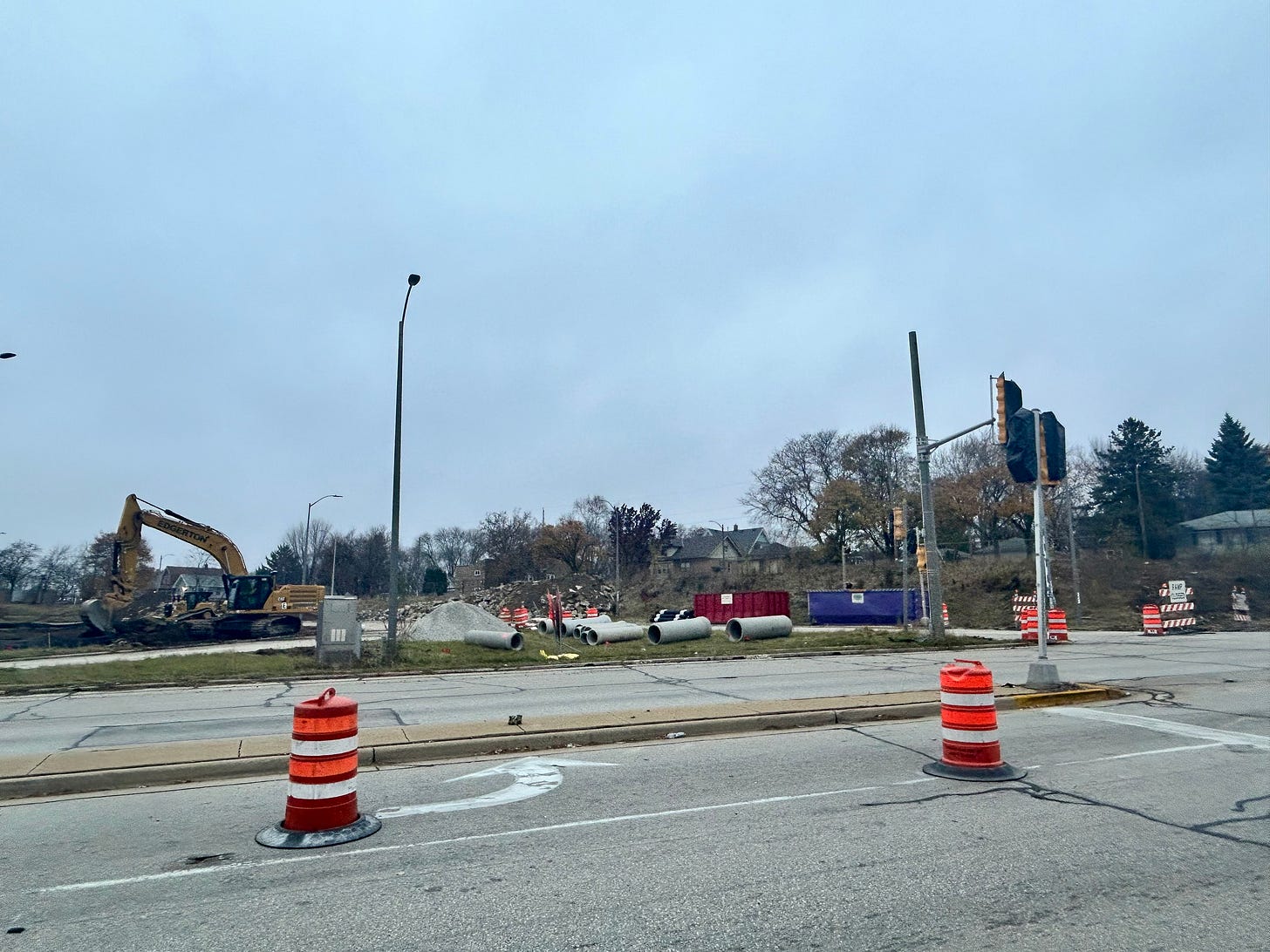The highway and the streetcar (and what we're missing)
As highway widening gets unceremoniously underway and the latest streetcar debate goes in another circle, the bus system and looming cuts to key routes seems left behind.
The Recombobulation Area is a 19-time Milwaukee Press Club award-winning opinion column and online publication founded by longtime Milwaukee journalist Dan Shafer. The Recombobulation Area is now part of Civic Media.
There was no formal press conference marking the official beginning of the project. No ribbons to be cut with comically-large scissors, no ceremonial shovels in the dirt, no dignitaries or elected officials giving the typical self-congratulatory speeches that might come at the onset of a multi-billion dollar effort.
The megaproject may have begun quietly, as far as public project pomp and circumstance goes, but the official start of the I-94 East-West widening and expansion certainly made a loud arrival. All kinds of lane and ramp closures began popping up beginning the week of Nov. 3. This begins what is projected to be an eight-year project sure to snarl traffic along this 3.5-mile stretch of freeway on the west side of Milwaukee County well into the 2030s, costing an estimated $1,700,000,000 (and likely more).
Meanwhile, in the weeks prior to this interstate project getting unceremoniously underway, at City Hall in downtown Milwaukee, a different kind of public project debate resurfaced for the umpteenth time. As part of the city’s budget process, Alderman Scott Spiker, who represents District 13 on the far south side, railed against — what else? — the streetcar. In multiple press releases, Spiker criticized the eight-year-old project, picking up the anti-streetcar torch from failed city politicians before him like Bob Donovan and Tony Zielinski.
The subsequent debate followed familiar territory — opponents say it’s wasteful and ineffective; supporters say it more-or-less pays for itself with property value increases and economic development along the route — and ignited the typical media circus that’s followed every streetcar debate for more than a decade. I wrote about the possibility of the streetcar in a November 2014 Milwaukee Magazine cover story; I did not think this still would be a headline-grabbing issue 11 years later.
This recurring debate manages to be somehow even more circular than the streetcar loop itself, and Ald. Spiker’s moronic crusade only served to embolden the same anti-Milwaukee forces that will gleefully dump on the city at every opportunity. In the city’s budget process, Spiker’s effort went nowhere — but now you’ve given more and more fuel to people who want to trash or defund the city. Heckuva job, Spiker.
And sure, there are plenty of valid criticisms of “The Hop,” but the debate over this particular transportation project lacks perspective. More relevant to this larger discussion is the annual operating cost of the streetcar, which is less than one half of 1% of the City of Milwaukee’s budget, at just over $4 million per year.
The outrage over this project is so far beyond commensurate to the actual scope of it, which in reality, is a fairly small public works project in a very large city. Opposition to the highway widening project has received only a mere blip of coverage compared to that of “The Hop,” even though the streetcar would have to run for roughly the next 425 years to approach the estimated cost of the mammoth $1.7 billion highway widening effort. Even if you think the streetcar completely sucks, it’s like complaining about a faulty door handle on a four-bedroom house.
If I tell you they’re going to be spending billions to widen a highway in America, nobody panics because it’s all part of the plan. Spend a miniscule fraction of that on a light rail project and everybody loses their mind. A snarky letter to the editor in the Milwaukee Journal Sentinel had a little fun with the dichotomy of the two projects, too, saying in the headline, “A traffic-snarled I-94 sure beats a walkable Milwaukee with a free streetcar.” I promise, it wasn’t me writing this one, though I am over here applauding passages like this one:
“Wisconsin, despite occasional detours into “alternative transit,” has wisely charted a course for true progress: adding lanes. The wisdom of this choice manifests itself all around us. Just look at the flawless, free-flowing utopias of Los Angeles, Chicago and Atlanta, where traffic congestion was solved decades ago.”
Longtime readers of this publication know where we stand on the I-94 widening project; it was the topic of our award-winning multi-part series, “Expanding the Divide,” and we’ve been opposed to the widening effort from the jump. As construction begins, it is already seeming even worse than we’d anticipated. The configuration of lane closures on the highway and road closures on city streets is unfathomably moronic. I guess we shouldn’t be surprised when these decisions are coming from the state agency that gave us this:

As a resident of the west side of Milwaukee, I’ll probably be spending the next eight years angry with Gov. Evers for approving the colossal boondoggle of a highway widening project as the effects of it negatively impact the neighborhoods on this side of town that otherwise would be poised for genuine growth and opportunity for no meaningful long-term benefit of anyone (besides highway-builder lobbyists).
And Evers was not even in Wisconsin the week this project formally launched, but instead in Brazil at a U.N. Climate Change Conference in his role as U.S. Climate Alliance Co-Chair. The irony of this is not lost on me, as highway expansion opponents cited Evers’ own Task Force on Climate Change in their surprise and disappointment that he’d revived the Walker-era widening project.
But beyond the bloated, overbuilt highway project and the relatively mediocre streetcar, you’ll find the real transportation crisis lurking in Milwaukee — the underfunded bus system that’s been embroiled in turmoil.
The Milwaukee County Transit System (MCTS) has had a rough year. The transit agency blindsided county officials with a budget deficit of more than $10 million earlier this year, which led to multiple resignations from top transit officials and an audit initiated by the county comptroller. Reports of rampant fare evasion only made things worse, both from a budgetary standpoint and a public perception one. Cuts became inevitable, and despite efforts to shrink the size of those cuts during the County Board’s budget process, a number of key routes will be on the chopping block when MCTS presents its service plan for 2026 next month, following the finalized $1.39 billion County budget signed by County Executive David Crowley.
More than six years ago in this space, I wrote about how Milwaukee had been going backwards on bus transit. Two years ago, I wrote about the launch of the new East-West Bus Rapid Transit line, and its potential to transform the beleaguered bus system. Last year, I wondered if we might be at an inflection point for transit in Milwaukee.
Clearly, we’re not. We have not reached a turning point. We are not making progress. We are still going backwards.
And as the streetcar’s future stalls and the hulking highway expands, the means of transportation for tens of thousands of working people in Milwaukee County are slated for elimination, including routes 20, 28, 33, 34, 55 and 58 (yes, even the Giannis Line could be cut). This could be the start of a “death spiral” for the system, noted Urban Milwaukee’s Jeramey Jannene when news of these route cuts were first proposed.
That, obviously, would be unacceptable. And though the recent mismanagement has clearly made things worse, decades of constantly deprioritizing and defunding the bus has certainly contributed to putting us in this perilous position. We always seem to be able to find funding for highway expansions, but never is a major influx of funding for MCTS even proposed, much less approved. The annual expenses of the entire system, by the way, is just over $150 million — less than 1% of the I-94 East-West highway widening project.
I would certainly prefer increasing funding for the bus system or adding a new BRT line than to add another highway lane, foolishly thinking that this is the time that another lane will fix traffic. And I would also prefer increasing funding for MCTS than to expand the downtown streetcar. It is a far, far greater priority. But right now, neither seems likely. And Waukesha County officials are already pushing for another I-94 megaproject to widen the interstate there. There always seems to be plenty of funding available to help suburban commuters shave a minute or two off of their daily trip, but never is there funding available to help working people in Milwaukee take the bus to get to their job on time.
The state of transportation in southeastern Wisconsin is extraordinarily bleak at the moment, as we stare down at least eight more years of highway construction, an endlessly circular streetcar debate, and cut after cut after cut to the beleaguered bus system. What very recently seemed like an inflection point for substantial growth and meaningful change has quickly devolved into the same old story of a managed decline, with the citizens of Milwaukee again left in the lurch.
Miss any of the latest from The Recombobulation Area? Find it here (and subscribe so you don’t miss a thing!).
Dan Shafer is a journalist from Milwaukee who writes and publishes The Recombobulation Area. In 2024, he became the Political Editor of Civic Media. He’s written for The New York Times, The Daily Beast, Heartland Signal, Belt Magazine, WisPolitics, and Milwaukee Record. He previously worked at Seattle Magazine, Seattle Business Magazine, the Milwaukee Business Journal, Milwaukee Magazine, and BizTimes Milwaukee. He’s won 23 Milwaukee Press Club Excellence in Journalism Awards. He’s on Twitter at @DanRShafer.
Subscribe to The Recombobulation newsletter here and follow us on Facebook and Instagram at @ therecombobulationarea.
Already subscribe? Get a gift subscription for a friend.
Part of a group who might want to subscribe together? Get a group subscription for 30% off!
Follow Dan Shafer on Twitter at @DanRShafer and at BlueSky at @danshafer.bsky.social.









